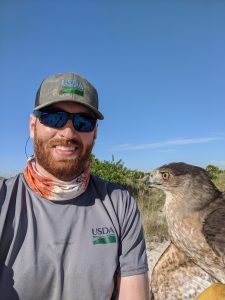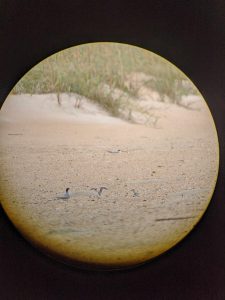By Katrina Rossos
University of Florida senior Nathaniel Owenby spent the summer interning with the USDA Wildlife Service. Originally from Lexington, North Carolina, the wildlife ecology and conservation major became a member of the USDA Wildlife Services’ wildlife damage operations team. The team handles a variety of management issues, so Owenby’s daily responsibilities were wide-ranging.
“One day I could be trapping nest predators, and the next I could be preparing feral hog blood samples for disease testing,” he said of the experience.
Owenby is interested in avian ecology and conservation, invasive species, and wildlife damage, and this internship exposed him to every one of these ecological focuses.

Some of the daily projects included controlling predators to protect endangered species, trapping feral hogs in national parks, removing problematic wildlife from timber operations, and managing wildlife at public airports or military airbases.
Reducing aircraft strikes with wildlife was a fascinating process, according to Owenby. He explained that Wildlife Services strives to make the airport campus as unappealing as possible to deter animals from the area. They also must remove carrion from the sites to ensure vultures and other scavengers do not linger.
From these experiences, Owenby said he gained a fuller comprehension of species trapping methods, such as snares, cages, and goshawk and hog traps. Since he was not introduced to these skills through university courses, he said he feels lucky to have been able to receive hands-on experience with the USDA Wildlife Service.
“While I was fortunate enough to get the chance to take part in all of these projects, the project that I worked on the most this summer was doing predator control for least tern colonies in St. Augustine,” Owenby said.

Least terns are shorebirds that nest on beaches and their eggs and chicks are preyed upon by many small-to-medium-sized mammals, such as coyotes, raccoons, opossums, and rats.
Owenby and the team conducted track surveys for nest predators and observed the least tern colonies to note successful fledglings or significant losses. This field work taught him a significant amount about mesopredator ecology in connection with nest predation.
Of all the days spent at the internship, Owenby said the most memorable was the day he spoke with the head shorebird biologist at Florida Fish and Wildlife Conservation (FWC). They discussed the number of fledging least tern chicks this summer in comparison to last year’s numbers.
“Most of the colonies did better than they had in years, and it was an incredible sense of accomplishment to know that I played a direct role in that,” said Owenby. “I think the most important lesson I learned this summer though is that the work that Wildlife Services takes part in is very important and can end up having a huge influence on threatened and endangered species.”
While he is currently researching how to increase avian diversity in urban environments, Owenby has been offered a temporary position with USDA Wildlife Services during his senior year. As he continues to work toward his degree, he will help the agency on a variety of projects, and he would like to continue working with them after he graduates.
 0
0
